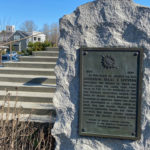One of Pacific Northwest’s most important founding documents is on display
Feb 19, 2020, 10:26 AM
One of the most important founding documents in the history of the Pacific Northwest, dating back to January 1855, is on temporary display at the Tulalip Indian Reservation in Snohomish County.
The Treaty of Point Elliott was signed by government officials and Native Americans at Mukilteo on January 22, 1855. At its most basic level, the document led to creation of the Tulalip, Port Madison, Swinomish. and Lummi reservations. There’s a monument in Mukilteo, up the hill from the ferry dock, that was dedicated in 1930.
Point Elliott is one of a handful of treaties that controversial figure, Washington Territorial Governor Isaac Stevens, gets the credit — as well as the blame — for making happen. The treaties created the system of reservations and tribes that are still in place.
They treaties made promises about providing services to Natives such as education and healthcare, as well as agreements related to access to fisheries and other natural resources. In exchange, Native Americans ceded millions of acres of land, giving formal possession to the federal government, and making way for settlers.
The actual 1855 document — with the signature of Governor Stevens and Chief Seattle’s ‘X’ and that of dozens of other natives — is on display at the Hibulb Cultural Center on the Tulalip Reservation near Marysville.
Patti Gobin is a Tulalip member who works for tribe in its Treaty Rights office.
“We are standing along the Quil’Ceda Slough,” Gobin said earlier this week in a gallery filled with artifacts and photos. “It’s not a museum. It’s a cultural center. We’re still living our culture. It’s alive.”
Gobin says the center is directly across the water from the original Hibulb family site, a Native village that once stood along what’s now the Everett waterfront. She says tribal leadership wanted a place where they could tell the Tulalip story to their own children and grandchildren, as well as to non-Natives, “so they can learn of who we are, that our culture is so intricate, so beautiful and still alive.”
The treaty is featured in an exhibit called “The Power of Words: A History of Tulalip Literacy,” and the 1855 document is something of a first written chapter of an often painful Native history.
Gobin’s late grandmother, Harriette Shelton Dover, is featured in the exhibit, and Gobin describes the way her grandmother suffered as a little girl in the Catholic school on the reservation, where non-Natives worked to suppress Native language and cultural practices.
“We didn’t know so many of our songs in our language,” Gobin said, because her grandmother had been punished for even speaking her Native tongue. “And so therefore she wouldn’t teach me, her granddaughter, [the language or the songs] because she didn’t want me to be hurt the way she was hurt.”
In an email, Hibulb Cultural Center curator Tessa Campbell said it was a lengthy and involved process to get the Treaty of Point Elliott to Tulalip.
“It took about one year of planning,” Campbell wrote. “The first step is to make a formal request via email to the National Archives in Washington, D.C.,” Campbell continued.
She then had to complete an exhaustive review and demonstrate the safety and artifact handling capabilities of the center. Permission was granted in September 2019; the treaty went on display in January, and will remain on view until July 25.
Given that reservations and the schools and other programs that followed all can be traced to the Treaty of Point Elliott, it is perhaps an understatement to describe it as a complex document and artifact. When it was signed (and eventually ratified), it simultaneously created and defined tribal entities, and, at the same time, it also constricted and constrained those tribes it had created.
It might seem odd, but the Tulalip and other tribes actually celebrate the anniversary of the treaty every January 22.
“I think the thing we celebrate the most is that our ancestors had the foresight to know that we would be here today and 2020,” Patti Gobin said. “They knew that we would have to have access to our ‘usual and accustomed fishing and hunting grounds,’” Gobin said, referencing language in Article 5 of the treaty that promised fishing and hunting rights to Native Americans.
“I’ve read the journals, and all of our leaders, each one of them, were heartsick” at signing a treaty that gave up land – which, in Native culture, wasn’t even really something that could be “owned” by anyone – in exchange for promises from the federal government, Gobin says.
“What they did say that sticks out in my mind is, ‘How are we going to feed our people?,’” Gobin said, crediting her ancestors for worrying how subsequent generations would feed themselves, as their ancestors had done for thousands of years before the arrival of Europeans in the Pacific Northwest.
Speaking of understatements, the negotiation process led by Isaac Stevens 165 years ago was anything but ideal, especially for Natives Americans.
Indigenous cultures in the Pacific Northwest had no written language, and spoken languages differed considerably even between villages. Thus, the specifics of the treaty were discussed in Chinook, a trading jargon with only a limited number of basic words. But the treaty itself is written in English.
As leader of the treaty process, was Isaac Stevens a villain?
“I guess I wouldn’t define him as a villain,” Patti Gobin said, obviously thinking hard about the question. “I would define him as, I don’t think ‘ignorant’ is the right word, but any prejudice against any people, to me, is ignorance.”
In exchange for the millions of acres land that Natives ceded through the treaty process, the federal government did promise certain things that are still contentious today. One example is the “Boldt Decision” of 1974, a landmark court case based on the treaties that codified tribal rights to fisheries.
Tulalip Tribal Councilmember Marlin Fryberg’s relationship with the treaty is as complex as the treaty itself. He’s proud that his ancestor’s signature is on the document now on display at Tulalip.
“The Indian name that I carry is actually on here,” Fryberg said, leaning over the sturdy case where the pages of the treaty are protected by glass. “I’m named after one of the treaty signers, myself and my uncle … ‘SHoolstSoot’ … one of the chiefs that signed the treaty, fourth or fifth generation to my family. So it certainly means a lot to myself and our family, as well as our people.”
So many people who now live in the Pacific Northwest can measure their family roots here in years or maybe decades. What’s it like for Marlin Fryberg to feel a family connection to the land stretching back millennia?
“It’s touching and it’s also sentimental because I’ve read the old documents of the treaty negotiations of our people, and it wasn’t pleasant times for them when they signed this treaty,” Fryberg said, expressing hope that more non-Natives would take the time to learn about the context and the complicated history of what happened at Point Elliott and that’s now preserved in ink and paper.
Fryberg is proud of his ancestor, but he seems frustrated by what the treaty has created and how it has continued to influence Native life.
“[There’s] a lot of that information people don’t know, and then folks wonder why we’re so guarded or why we’re so opinionated about this document, because this document we live by today, and some of us that have read the history know that our people died waiting for the services back in those days,” Fryberg said.
With more knowledge and understanding, Fryberg says, the general public “might get a different attitude of why we take the position we do with our treaty and all the things that were promised to us, because we fight for those today.”
This “duality” of the treaty is difficult to reconcile for someone who doesn’t live with its effects every day. On one hand, it’s an official federal government account, constituting written evidence of bad things that happened to Native Americans when they ceded lands 165 years ago in a less-than-perfect process. On the other, it’s a legal, binding contract that is still in effect, still being battled over today, and is ultimately accepted by many as a birth certificate of sorts for the social and cultural structure imposed on Native Americans in the 19th century.
For tribes like the Duwamish in Seattle, who remain unrecognized by the federal government, the treaties don’t even apply.
It’s clear that Marlin Fryberg, in his 15 years in tribal leadership at Tulalip, has thought about the Treaty of Point Elliott. A lot.
“It’s a promise between two governments, two sovereign nations: us and the President of the United States,” Fryberg said. “This document says they’re to keep their promises … as a tribal leader we see this time and time again … folks maybe not educated on what was signed, in the things that we are to receive for what we gave up.”
“Maybe they don’t want to ever be educated [about what was promised],” Fryberg continued, alluding to ongoing negotiations and legal battles with the federal government. “They’re just set in their ways, to come and still continue to take from us … but we will put up a fight.”
“All of all of our tribes unite [on big issues],” Fryberg said, because “we unfortunately have to live by this document.”
Patti Gobin is proud of what the Tulalip Tribes have done for themselves with economic development, job creation and self-sufficiency. She says the tribe is the fourth largest employer in Snohomish County.
But it also seems like the negative social and cultural effects of the treaty are never completely out of mind, and that maybe some of that self-sufficiency stems from the experiences of people like Gobin’s grandmother.
“We proved to be resilient. We’ve never let go of our culture,” Gobin said. “If it had to go in hiding when it was considered illegal to be Indian, it went in hiding, and that’s why we have songs, dances, our history, Hibulb [Community Center], all that we know here from our grandparents passing it on. And so I’m very humbly honored and thankful for what our elders did for us to preserve this way of life for us.”
“And here we are,” she added.
The Treaty of Point Elliott is on display at Tulalip Hibulb Cultural Center until July 25. To get there, take the Marysville exit from I-5 and go west about a mile.


















